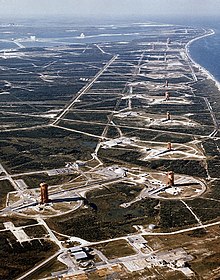|
Missile Row
 Missile Row was a nickname given in the 1960s to the eight SM-65 Atlas and HGM-25A Titan I launch complexes at the middle area of Cape Canaveral Space Force Station, historically used by the United States Air Force and NASA. Operated by the 45th Space Wing since 1949, it was the site of all fourteen Mercury-Atlas and Gemini launches, as well as many other early missile tests, Department of Defense launches, and NASA launches. Missile Row and Cape Canaveral played a secondary role to Vandenberg Air Force Base (now Space Force Base) in California for DoD launches, but it was used by many NASA launches of unmanned space probes, thanks to said spacecraft being typically launched on military vehicles. By the late 1960s and early 1970s, Missile Row gradually stopped being used thanks in part to the Atlas and Titan I's retirements as ICBMs in favor of the LGM-25C Titan II and LGM-30 Minuteman, both of which had their missile tests at Vandenberg. As for orbital launches, both the DoD and NASA moved away from the area in favor of Atlas-Centaur launches from the adjacent Launch Complex 36, Delta launches from Launch Complex 17 to the south, and Titan III launches from Launch Complexes 40 and 41 at the northern end of CCSFS. Additionally, NASA relocated all manned launches following LC-34's launch of Apollo 7 from Cape Canaveral to the nearby Kennedy Space Center, with every following launch of the Apollo Program, Apollo Applications Program, and Space Shuttle Program taking place at KSC's Launch Complexes 39A and 39B. Following the retirement of the Atlas-Agena in 1978, the only launches to come out of Missile Row were Pershing 1a and Pershing II tests by the United States Army from LC-16 in the 1980s and various sounding rockets from LC-20 in the 1990s. By 2001, none of the pads were in active use. After this period without any launches, Missile Row began getting its pads reactivated in the wake of the 2010s NewSpace boom. This started with Launch Complex 13 getting leased to SpaceX in 2015 as a landing area for the Falcon 9's first stage,[1] seeing first action with the landing of Orbcomm OG2's booster in December of that year. Following that, Launch Complexes 11 and 12 were leased to Blue Origin in 2017 as support to the operation of their New Glenn at the adjacent LC-36, with the pads being used for an engine test stand and storage area respectively. The region saw its first launch-oriented pad leases in 2019, with Firefly Aerospace getting LC-20 for the Firefly Alpha[2] and Relativity Space getting LC-16 for the Terran 1. More leases came in March 2023, when the historic Launch Complex 14 (famous for being the launch site of Friendship 7) was leased to Stoke Space for their Nova rocket, while LC-15 was given to ABL Space Systems for their RS1.[3] Additionally, LC-13 was announced to be leased to Phantom Space and Vaya Space for their respective Daytona and Dauntless launch vehicles following the expiration of SpaceX's lease.[3] The first launch in Missile Row since the 1970s occurred later that month with the only flight of the Terran 1, ended in failure and was swiftly retired by Relativity, deciding on developing the much larger Terran R instead.[4] Following ABL's departure from the space launch market in November 2024, the only Missile Row pads not leased out are Launch Complex 15 and Launch Complex 19, the historic launch site of the Gemini missions. Much of the support activity for Cape Canaveral Space Force Station occurs at Patrick Space Force Base to the south, its reporting base. List of sitesActive launch vehicles are in bold. Active sitesSome of the launch complexes have been recommissioned for modern space vehicle launches.
Sites leased for future useSome of the launch sites have been leased out to various NewSpace companies for future use.
Inactive Sites
References
External links |